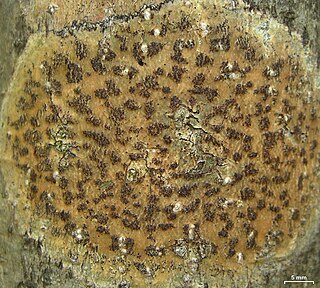
Cochliobolus lunatus is a fungal plant pathogen that can cause disease in humans and other animals. The anamorph of this fungus is known as Curvularia lunata, while Cochliobolus lunatus denotes the teleomorph or sexual state. They are, however, the same biological entity. Cochliobolus lunatus is the most commonly reported species in clinical cases of reported Cochliobolus infection.

The Pleosporales is the largest order in the fungal class Dothideomycetes. By a 2008 estimate it contains 23 families, 332 genera and more than 4700 species. The majority of species are saprobes on decaying plant material in fresh water, marine, or terrestrial environments, but several species are also associated with living plants as parasites, epiphytes or endophytes. The best studied species cause plant diseases on important agricultural crops e.g. Cochliobolus heterostrophus, causing southern corn leaf blight on maize, Phaeosphaeria nodorum causing glume blotch on wheat and Leptosphaeria maculans causing a stem canker on cabbage crops (Brassica). Some species of Pleosporales occur on animal dung and a small number occur as lichens and rock-inhabiting fungi.
The Cucurbitariaceae are a family of fungi in the order Pleosporales. Taxa are widespread in temperate regions and are necrotrophic or saprobic on woody plants.
The Delitschiaceae are a family of fungi in the order Pleosporales. Taxa are widespread, especially in temperate regions, and are saprobic, often found growing in herbivore dung.
The Diademaceae are a family of fungi in the order Pleosporales. Taxa are widespread, especially in temperate regions, and are parasitic or saprobic in stem and leaves.
The Lophiostomataceae are a family of fungi in the order Pleosporales. Taxa have a widespread distribution, especially in temperate regions, and are saprobic or necrotrophic on herbaceous and woody stems.
The Massariaceae are a family of fungi in the order Pleosporales. Taxa have a cosmopolitan distribution, but are better known in more temperate zones. Although the family is poorly known, it has been suggested that they are saprobic in wood and bark, with a few species being weak pathogens.
The Melanommataceae are a family of fungi in the order Pleosporales. Taxa are widespread in temperate and subtropical regions, and are saprobic on wood and bark.
The Montagnulaceae are a family of fungi in the order Pleosporales.
The Phaeosphaeriaceae are a family of fungi in the order Pleosporales. Species in the family have a cosmopolitan distribution, and are generally nectrotrophic or saprobic on a wide range of plants.
The Pleomassariaceae are a family of fungi in the order Pleosporales. Taxa have a widespread distribution in both temperate and tropical regions, and are saprobic or necrotrophic on wood, bark, and other herbaceous material.
The Sporormiaceae are a family of fungi in the order Pleosporales. Taxa have a cosmopolitan distribution and are saprobic on dung (coprophilous) and rotting vegetation.
The Teichosporaceae are a family of fungi in the order Pleosporales.
The Testudinaceae are a family of fungi in the order Pleosporales. Taxa have a widespread distribution, especially in xeric habitats, and are mostly saprobic.
The Zopfiaceae are a family of fungi in the order Pleosporales. Taxa have a widespread distribution, and appear to be saprobic, found largely on rhizomes and roots. Some species are found in marine environments.
The Didymosphaeriaceae are a family of fungi in the order Pleosporales. The family was erected by Anders Munk in 1953.
The Massarinaceae are a family of fungi in the order Pleosporales. Although taxa have a cosmopolitan distribution, they are better-known in temperate regions. They are thought to be saprobic in wood and bark; some species are weak pathogens.

Lophiostoma is a genus of ascomycetous fungi in the family Lophiostomataceae.
The Leptosphaeriaceae are a family of fungi in the order Pleosporales. The family was circumscribed by mycologist Margaret E. Barr in 1987. According to the Dictionary of the Fungi, the family contains 8 genera and 302 species. The family has a widespread distribution, but is especially prevalent in temperate regions. Species are either saprobic or grow as nectrotrophs on the stems or leaves of plants.

The Trypetheliales are an order of fungi in the class Dothideomycetes. Most of the species in the order form lichens, although some are lichenicolous fungi. Trypetheliales contains two families, Polycoccaceae and Trypetheliaceae. The order was circumscribed in 2008 by lichenologists Robert Lücking, André Aptroot, and Harrie Sipman.




